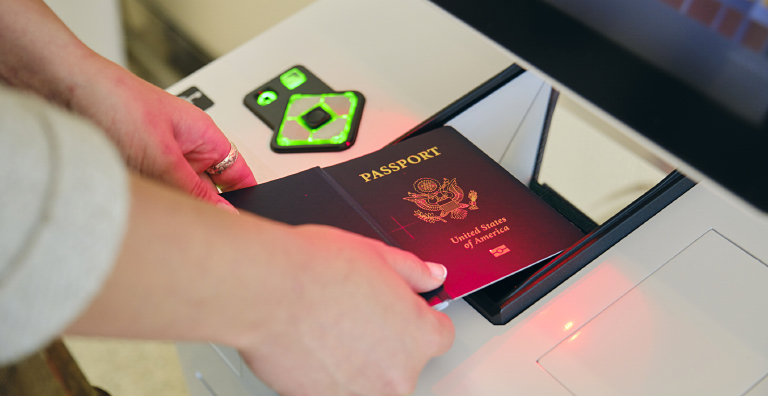Imagine this: It’s peak check-in time at a busy hotel. The front desk is backed up, guests are frustrated and staff are stuck manually entering ID details — taking five minutes per guest. But with a professional ID scanner in place, check-ins drop to just 30 seconds. The system extracts ID data, auto-fills forms and verifies authenticity, all in one seamless step.
Curious how it works? Let’s break down what happens in those first few seconds — and how it builds trust.
What Happens During Those First Few Seconds
Full page ID and passport scanners do far more than take images of ID document data pages. They conduct and launch a series of advanced processes designed to verify identity and detect fraud instantly. Here’s what’s happening behind the scenes:
1. Automatic Document Recognition
The scanner instantly identifies the document type and configures appropriate reading protocols, knowing exactly which security features to check and which data fields to extract.
2. Multispectral Image Analysis
Using multiple wavelengths of light, scanners expose visible and invisible security features, catching counterfeit ID documents before they reach your system.
3. RFID Chip Communication
Modern passports and enhanced IDs contain encrypted biometric chips. Scanners securely extract this chip data and cross-check it against visible document details, exposing forgeries that can fool the human eye.
4. Optical Character Recognition (OCR)
Advanced algorithms simultaneously read two critical zones, cross-checking for inconsistencies that signal fraud:
- Machine-Readable Zone (MRZ) — The coded lines at the bottom of ID documents
- Visual Inspection Zone (VIZ) — Biographic data elements from the ID
5. Digital and Physical Document Processing
Advanced passport and ID scanners handle both traditional physical documents and emerging digital credentials — a critical capability for integrators deploying future-ready verification solutions.
For example, when clients’ customers present mobile driver’s licenses (mDLs) on smartphones, the scanner starts the process by reading a QR code or NFC before securely retrieving the permitted data over Bluetooth® Low Energy® (BLE) communication. This dual capability means your ID integration supports both physical document workflows and emerging digital identity requirements, without additional hardware.
Authentication That Goes Deeper
After data extraction, specialized software runs authenticity checks on the ID’s data and security features:
- Physical security authentication — Holographic overlays and security foils, UV-reactive inks, microprinting and fine-line security patterns and tactile security elements
- Digital authentication — Biometric chip validation, digital signature verification from issuing authorities, B900 inspection (using cross-reference algorithms), facial image comparison between document and chip, mDL authentication
- Data consistency analysis — MRZ and VIZ correlation verification, data format and expiration validation, issuing authority authentication protocols
What Types of Documents Can Be Scanned?
Modern ID and passport scanners process a wide range of IDs:
- Physical documents — ICAO 9303 compliant passports, national electronic ID cards with biometric chips, ISO 18013 driver’s licenses, machine-readable visas (MRVs) with country-specific security features, voter ID cards, military and government IDs
- Digital identity credentials — Mobile driver’s licenses (mDLs) displayed on smartphones, QR-based digital identity tokens, BLE proximity sharing
Who’s Using This Technology and Why
Across industries this technology is transforming operations:
- Hospitality — Fast, accurate guest verification during check-ins, fewer fraudulent reservations
- Banking and Financial Services — KYC compliance with audit-ready documentation and sophisticated fraud prevention
- Airports and Border Control Agencies — Rapid, secure authentication of ICAO 9303-compliant passports and visas to streamline passenger processing
- Vehicle Rental Companies — Identity verification, revenue loss mitigation, license validation (domestic and international)
- Gaming and Casinos — Instant age verification, anti-money laundering safeguards
Building Trust, One Scan at a Time
Professional ID scanners today are more than just document readers — they’re intelligent gatekeepers. By combining high-resolution imaging with smart software, they verify identities with precision that manual checks simply can’t match.
And when you layer in facial recognition and cloud-based database integration, you get a seamless, secure identity experience that’s built for scale. It’s not just about catching fakes — it’s about building trust, one scan at a time.
Want smoother operations and stronger security? Contact our specialists to explore how modern ID verification technology can reduce fraud, speed up workflows and boost customer trust.

